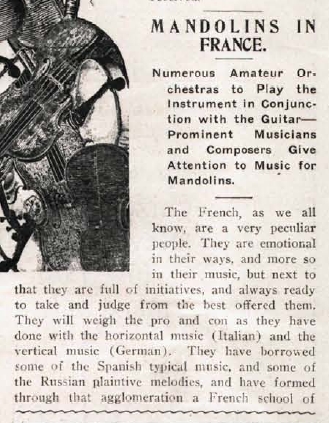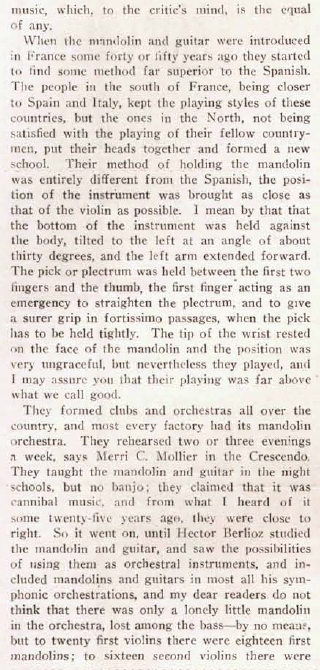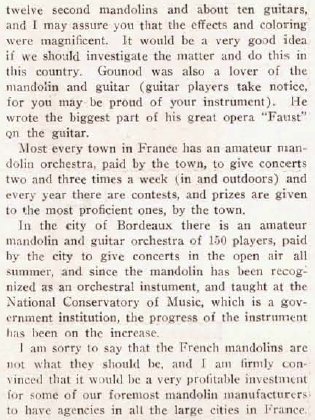| Music Trade Review |
|
Die Zeitschrift Music Trade Review ist online verfügbar: |
|
Music Trade Review - Music
Industry Magazine
Online Library: 1880 - 1933, 1940-1954 The Music Trade Review was published out of New York from 1878 until at least 1956. It apparently suspended publication with the January 1933 issue. Publication was resumed under different management sometime between 1937 and 1940. Our online library contains issues from 1880 to 1933, and from 1940 to 1954. Additional years are available for review at a number of libraries. Search www.worldcat.org for more information about the holdings of other libraries, or ask your local librarian for assistance. |
| |
| --
google Anzeige -- |
| Bitte
teilen sie diese Seite: |
 |
 |
 |
MANDOLINS IN FRANCENumerous Amateur Orchestras to Play the Instrument in Conjunction with the GuitarProminent Musicians and Composers Give Attention to Music for Mandolins.The French, as we all know, are a very peculiar people. They are emotional in their ways, and more so in their music, but next to that they are full of initiatives, and always ready to take and judge from the best offered them. They will weigh the pro and con as they have done with the horizontal music (Italian) and the vertical music (German). They have borrowed some of the Spanish typical music, and some of the Russian plaintive melodies, and have formed through that agglomeration a French school of music, which, to the critic's mind, is the equal of any. When the mandolin and guitar were introduced in France some forty or fifty years ago they started to find some method far superior to the Spanish. The people in the south of France, being closer to Spain and Italy, kept the playing styles of these countries, but the ones in the North, not being satisfied with the playing of their fellow countrymen, put their heads together and formed a new school. Their method of holding the mandolin was entirely different from the Spanish, the position of the instrument was brought as close as that of the violin as possible. I mean by that that the bottom of the instrument was held against the body, tilted to the left at an angle of about thirty degrees, and the left arm extended forward. The pick or plectrum was held between the first two lingers and the thumb, the first finger acting as an emergency to straighten the plectrum, and to give a surer grip in fortissimo passages, when the pick has to be held tightly. The tip of the wrist rested on the face of the mandolin and the position was very ungraceful, but nevertheless they played, and I may assure you that their playing was far above what we call good. They formed clubs and orchestras all over the country, and most every factory had its mandolin orchestra. They rehearsed two or three evenings a week, says Merri C. Mollier in the Crescendo. They taught the mandolin and guitar in the night schools, but no banjo; they claimed that it was cannibal music, and from what I heard of it some twenty-five years ago, they were close to right. So it went on, until Hector Berlioz studied the mandolin and guitar, and saw the possibilities of using them as orchestral instruments, and included mandolins and guitars in most all his symphonic orchestrations, and my dear readers do not think that there was only a lonely little mandolin in the orchestra, lost among the bass—by no means, but to twenty first violins there were eighteen first mandolins; to sixteen second violins there were twelve second mandolins and about ten guitars, and I may assure you that the effects and coloring were magnificent. It would be a very good idea it we should investigate the matter and do this in this country. Gounod was also a lover of the mandolin and guitar (guitar players take notice, for you may be proud of your instrument). He wrote the biggest part of his great opera "Faust" on the guitar. Most every town in France has an amateur mandolin orchestra, paid by the town, to give concerts two and three times a week (in and outdoors) and every year there are contests, and prizes are given to the most proficient ones, by the town. In the city of Bordeaux there is an amateur mandolin and guitar orchestra of 150 players, paid by the city to give concerts in the open air all summer, and since the mandolin has been recognized as an orchestral instument, and taught at the National Conservatory of Music, which is a government institution, the progress of the instrument has been on the increase. I am sorry to say that the French mandolins are not what they should be, and I am firmly convinced that it would be a very profitable investment for some of our foremost mandolin manufacturers to have agencies in all the large cities in France. |
|
|
| Wenn
sie diese Seite
ohne Navigationsleiste angezeigt bekommen, dann klicken sie hier um die MandoIsland Homepage zu öffen: |
 |